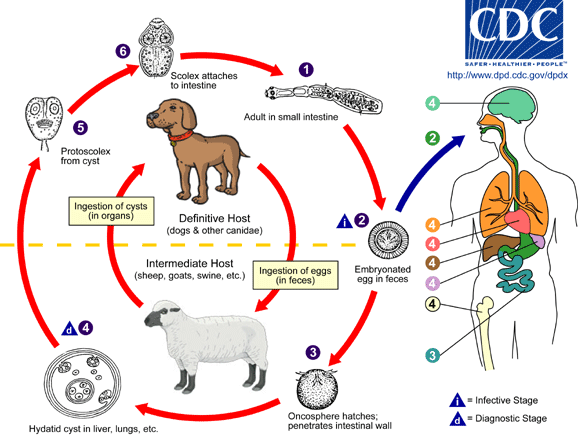Echinococcosis pathophysiology: Difference between revisions
| Line 28: | Line 28: | ||
===Gross Pathology=== | ===Gross Pathology=== | ||
Shown below is an image of a typical [[cyst]] at removal. | Shown below is an image of a typical [[cyst]] at removal. | ||
[[Image:hydatid_cyst_membrane.jpg | [[Image:hydatid_cyst_membrane.jpg|250 px|center|frame|Courtesy dedicated to wikimedia.com]] | ||
== References == | == References == | ||
Revision as of 23:21, 20 August 2017
|
Echinococcosis Microchapters |
|
Diagnosis |
|---|
|
Treatment |
|
Case Studies |
|
Echinococcosis pathophysiology On the Web |
|
American Roentgen Ray Society Images of Echinococcosis pathophysiology |
|
Risk calculators and risk factors for Echinococcosis pathophysiology |
Editor-In-Chief: C. Michael Gibson, M.S., M.D. [1] Associate Editor-In-Chief: Cafer Zorkun, M.D., Ph.D. [2]; Kalsang Dolma, M.B.B.S.[3]
Overview
The transmission of echinococcosis from the definitive host to the intermediate host is by ingestion of embryonated eggs passed in the feces. Once the eggs are ingested they hatch in the small intestine and develop into onchospheres. There oncospheres reach various organs by migration through the vascular system and develop into cysts producing protoscolices. The definitive host is infected by ingestion of the organs infected with the cysts. After ingestion of the cysts they evaginate and invade the intestinal mucosa and develop into adult worms.
Pathophysiology
Life cycle

(1)The adult Echinococcus granulosus (2) Embryonated eggs (3) Oncosphere (4) Cyst (5) Protoscolices (6) Protoscolices evaginating
Trasmission of infection
- The transmission of echinococcosis from the definitive host (dogs and other carnivores) to the intermediate host (sheep, goats, swine etc) occurs by the ingestion of embryonated eggs passed in the feces.
- The definitive host is infected by the ingestion of cyst containing organs of the infected intermediate host (sheep, goats, swine, etc).
Pathogenesis
- The embronated eggs are excreted in the feces of the definitive host, which include dogs and other carnivores.
- The intermediate hosts include: sheep, cattle, horses and camel. Once ingested the eggs hatch in the small bowel and release oncospheres.
- The onchospheres penetrate the intestinal wall and migrate through the vascular system to organs such as liver and lung.
- In the lungs and liver the oncospheres develop into a cyst producing protoscolices and daughter cysts which fill the interior of the cyst.
- The definite host will be infected if they ingest organs containing cysts.
- Once ingested, the protoscolices evaginate and attach the intestinal mucosa.
- In 32 to 80 days after evagination the protoscolices develop into adult tapeworm.
- The life cycle of E. multilocularis is similar to the life cycle of Echinococcus granulosus, but with the following differences: The definitive hosts are foxes, and to a lesser extent dogs, cats, coyotes and wolves. The intermediate host are small rodents and the larval growth (in the liver) remains indefinitely in the proliferative stage, resulting in invasion of the surrounding tissues.
- In the life cycle of E. vogeli the definitive hosts are bush dogs and dogs. The intermediate hosts are rodents and the larval stage in the liver, lung develops both externally and internally, resulting in multiple vesicles.
- E. oligarthrus (up to 2.9 mm long) has a life cycle that involves wild felids as definitive hosts and rodents as intermediate hosts. Humans become infected by ingesting eggs , with resulting release of oncospheres in the intestine and the development of cysts in various organs.
Gross Pathology
Shown below is an image of a typical cyst at removal.
